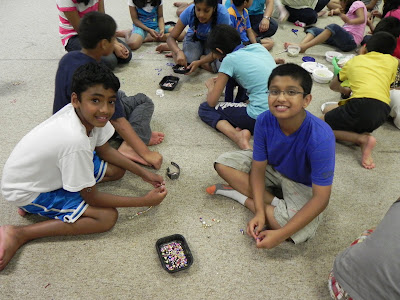Hari Om!
We started off our second day at summer camp with chanting the Ganesha Atharva Shirsham with Nirmala Aunti again - we learned the Shanti Mantra, the initial portion of the stotram, and the first two verses. We learned that we must not chant the stotram mechanically, that we must concentrate while doing Vedic Chanting because of the numerous differences in the intonation of the words.
Next on our schedule was Yoga time!


We ended Yoga by spending a few minutes in the relaxing Shavasan pose (also known as the "Dead Man's Pose").
In their classes, the older and younger children learned about the Srirangam and Brahadeeshwar Temples, respectively. The Srirangam Temple, often said to be the largest functional Hindu Temple, located in Srirangam, Tamil Nadu contains the idol of Lord Ranganatha, the reclining form of Lord Vishnu. Aneesha said of the deity in the Srirangam Temple: "The Ranganatha is a very famous idol that got stolen. The idol’s eyes were made of diamonds. The idol has great value and that’s why the people stole the famous idol."
The Brahadeeshwar Temple, in Thanjavur, Tamil Nadu, contains a huge Shiva Linga - the priests require a ladder to do Abhishekam for this Linga. Our friend, Aryaman said: "It was made by a King and it was really big and the whole thing was made out of granite - it was a ton of pounds! The Shiva Linga was really big - almost like 20 feet tall."
In the afternoon, the kids painted and decorated picture frames with Rupal Auntie!
ॐ















































